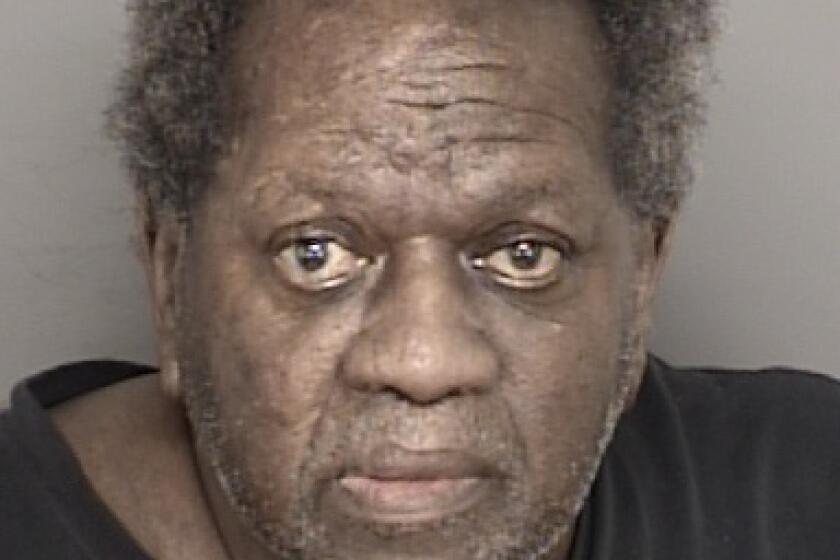Ralph Asdel, 82; Detective in the Black Dahlia Case
Ralph Asdel was a 26-year-old Los Angeles Police Department detective in 1947 when he was called in to help investigate what continues to be one of the city’s most famous unsolved murder mysteries.
Asdel, the last living detective from the original Black Dahlia investigation, died Dec. 31 of pneumonia in a health-care facility in Lancaster. He was 82 and never stopped believing he may have interviewed the killer 55 years ago.
The Black Dahlia case remains as haunting today as it was on Jan. 15, 1947, the day the mutilated body of Elizabeth Short, an unemployed cashier and waitress, was discovered in an empty lot in the 3800 block of South Norton Avenue in southwest Los Angeles.
Not only was Short’s body severed at the waist, but it had been cleaned and systematically drained of blood. Gashes also had been cut from the corners of her mouth and pieces of flesh had been sliced from her body. Medical examiners suspected that she had been tortured before she was killed.
The gruesome nature of the crime ensured a continuous stream of sensational newspaper headlines as detectives investigated the slaying of the mysterious, dark-haired woman dubbed the Black Dahlia. Short had been given the nickname by customers of a Long Beach drugstore she had frequented while living briefly in a nearby hotel.
The Alhambra-born Asdel, who had joined the Police Department in 1942, was one of many LAPD detectives loaned by different divisions to work on what became the largest manhunt of the day.
Within weeks of the murder, Asdel told a Times reporter on the 50th anniversary of the slaying, he tracked down a man he believed may have been the killer.
A neighbor in the area, according to newspaper accounts at the time, told police that about 9 on the night before Short’s body was discovered, he had driven by the empty lot on Norton Avenue and saw a light-colored 1935 sedan on the west side of the street with its right rear door open.
Standing next to the car was a thin man of medium height, in his mid-40s and wearing a tan topcoat and a dark hat pulled low.
The neighbor, who had planned to dump a load of garden clippings on the vacant lot, said he drove a bit farther before stopping on the east side of the street. His arrival apparently startled the thin man, who crossed the street and walked slowly toward the parked car. As he walked by, the man stared at the driver and then peered inside the car. Then he crossed the street and returned to his sedan.
The frightened neighbor, who had thought the man was going to rob him, quickly drove away but circled the block. When he drove by the sedan again, he saw that the back door was now closed and the man was behind the wheel.
When the man saw the neighbor’s car again, according to the newspaper account, he took off, with his gears grinding and his tires squealing.
Using the witness’ description and other tips, Asdel located a man he suspected of being the mysterious driver of the sedan. The man was working at a restaurant a few blocks from the crime scene.
During his interview with the man, Asdel discovered that his car had recently been painted black. Although Asdel turned in a report of the interview to his superiors, he told The Times in 1997, there was no proof that the man was the one spotted by the witness, and he was not pursued as a serious suspect.
The man and his freshly painted car, however, continued to nag at Asdel.
“Sometimes the good Lord gets you these feelings or hunches,” he told The Times. “You get the hair standing up on the back of your neck, whether it’s a routine traffic stop or whatever. You just know.”
Asdel conceded that he could be “500 miles off base.”
“But I don’t think so,” he said.
Asdel’s wife of 64 years, Hazel, said this week that her husband didn’t talk to her much about the case.
“He was a guy that never brought home his work,” she said. “He kind of kept it to himself.”
But time did not diminish her husband’s interest in the Black Dahlia case.
“He thought about it all the time,” she said.
Although Short’s killer may now be dead, Asdel continued to hope that someone who knew the killer might step forward with information even this many years later, and the case would be solved.
Asdel, who later became a motorcycle officer, injured his leg in an on-duty traffic accident and was forced to go on medical retirement in 1965. He worked as vice president in charge of security for Inland Bank in Pomona and helped MasterCard establish the ways the credit card company could be protected from fraud or duplication.
He later sold insurance in Bishop and served several years on the region’s air quality board.
In addition to his wife, Asdel is survived by his daughter, Carol Hollander of Santa Clarita; son Gary, of Geneva, Ala.; two sisters, Aldeth Godfrey and Helen Hagey, both of San Gabriel; seven grandchildren; and 13 great-grandchildren.
*
Times staff writer Larry Harnisch contributed to this report.
More to Read
Start your day right
Sign up for Essential California for news, features and recommendations from the L.A. Times and beyond in your inbox six days a week.
You may occasionally receive promotional content from the Los Angeles Times.






